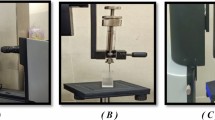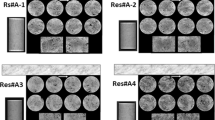Abstract
Extensive laboratory studies have shown that oil recovery from water flooding is dependent on the salinity and composition of the injected water. The potential of low-salinity waterflooding (LSWF) has been observed in field trials, with relatively good agreement with the measured laboratory data. However, the incremental recovery from LSWF is relatively modest (2–10 % OOIP) compared to other water-based EOR methods such as chemical methods, particularly when applied in tertiary mode. In this paper, we investigate low-salinity flooding combined with alkali to improve the incremental recovery. The recoveries are also compared with low-salinity brine combined with surfactant. This is studied in a system, which is first shown to be responsive to low salinity. The low-salinity recovery result is used as a baseline for comparison. A clay-rich core from a sandstone reservoir and crude oil were used. The flooding experiments were performed by successive injection of high-salinity formation brine and low-salinity water or low-salinity water combined with a surfactant or alkali (SDS/NaOH). Based on the results, without adding alkali or surfactant, low-salinity flooding recovered \(\sim \)4 % additional oil over the recovery from high-salinity injection. However, when combined with 1 wt% alkali/surfactant, the oil recovery increased to 7–17 % OOIP. Minor formation damage was observed in all experiments. Interfacial tension (IFT) reduction (capillary desaturation) in each combined method is envisaged to be the driving mechanism for the enhancement of oil recovery. Interfacial tension reduction decreases capillary pressure, thereby decreasing trapping or re-trapping of the mobilized oil by low-salinity flooding. Comparison of the recovery from surfactant-improved low salinity and alkali-improved low salinity indicates that higher oil recovery can be achieved with surfactant than with alkali. Higher efficiency with surfactant can be attributed to the lower attainable IFT with surfactant than alkali (higher capillary numbers). Nevertheless, due to lower costs, alkali is more cost effective than surfactant and is advantageous because it reduces adsorption of in-situ generated petroleum surfactant. The results of the study emphasize the benefits of hybrid methods for the improvement of oil recovery. Particularly where a reservoir is responsive to low salinity, recovery can be enhanced by the addition of a small amount of alkali or surfactant.











Similar content being viewed by others
Notes
Since the core samples are well consolidated and stress competent, the confining pressure has negligible influence on the permeability and porosity of the samples.
Abbreviations
- TAN:
-
Total acid number
- TBN:
-
Total base number
- dFW 0.1 :
-
Formation water diluted 10 times
- dFW0.01:
-
Formation water diluted 100 times
- DP:
-
Differential pressure
- DW:
-
Distilled water
- FW:
-
Formation water
- HS:
-
High salinity
- IFT:
-
Interfacial tension
- K :
-
Absolute (brine) permeability of core in each flooding step
- \(K_{\mathrm{init}}\) :
-
Initial absolute (brine) permeability of core
- LS:
-
Low salinity
- LSWF:
-
Low-salinity water flooding
- LSWF-A:
-
Low-salinity water with alkali
- LSWF-S:
-
Low-salinity water with surfactant
- OOIP:
-
Oil originally in place
- PV:
-
Pore volume
- ROS:
-
Remaining oil saturation
- \(S_{\mathrm{wi}}\) :
-
Initial water saturation
- \(S_{\mathrm{or}}\) :
-
Residual oil saturation
- SDS:
-
Sodium dodecyl sulfate
- TDS:
-
Total dissolved solid
- \(v_{\mathrm{w}}\) :
-
Displacement velocity
- \(\mu _{\mathrm{w}}\) :
-
Viscosity of displacing phase
- \(\sigma _{\mathrm{ow}}\) :
-
Oil/brine interfacial tension (IFT)
References
Abdulrazag, Z.Y., Al-Fateh, M.N., Al-Arabai Z.: Effect of EOR technology on Wettability and Oil Recovery of Carbonate and Sandstone Formation, Paper IPTC 14131, presented at the International Technology Conference held in Bankok, Thailand (2012)
Alagic, E.K.S., Skauge, A., Solbakken, J.: Effect of crude oil aging on low salinity and low salinity surfactant flooding. J. Petrol. Sci. Eng. 78, 220–227 (2011)
Alagic, E., Skauge, A.: Combined low salinity brine injection and surfactant flooding in mixed-wet sandstone cores. Energy Fuels 24, 3551–3559 (2010)
Alotaibi, M.B., Nasr-El-Din, H.A.: Chemistry of injection water and its impact on oil recovery in carbonate and clastic formations. In: Paper SPE 121565 presented at the SPE International Symposium on Oilfield Chemistry, 20–22 April, The Woodlands (2009)
Austad, T., et al.: Chemical mechanism of low salinity water flooding in sandstone reservoirs. In: SPE 129767. SPE IOR Symposium, Tulsa (2010a)
Austad, T., RezaeiDoust, A., Puntervold, T.: Chemical Mechanism of Low Salinity Water Flooding in Sandstone Reservoirs. In: Paper SPE 129767, presented at the SPE Improved Oil Recovery Symposium. SPE, Tulsa (2010b)
Bernard, G.G.: Effect of floodwater salinity on recovery of oil from cores containing claysin. In: Paper SPE 1725. SPE, Los Angeles (1967)
Boussour, S., Cissokho, M., Cordier, P., Bertin, H., Hamon, G.: Oil Recovery by Low Salinity Brine Injection: Laboratory Results on Outcrop and Reservoir Cores. In: SPE 124277 (2009)
Clementz, D.M.: Clay stabilization in sandstones through adsorption of petroleum heavy ends. J. Petrol. Technol. 29, 1061–1066 (1977)
Crocker, M.E., Marchin, L.M.: Wettability and adsorption characteristics of crude-oil asphaltene and polar fractions. J. Petrol. Technol. 40, 470–474 (1988)
Denekas, M.O., Mattax, C.C., Davis, G.T.: Effects of crude oil components on rock wettability. Petrol. Trans. AIME 216, 330–333 (1959)
Dubey, S.T., Doe, P.H.: Base number and wetting properties of crude oil. SPE Reservoir Eng. 8, 195–200 (1993)
Fadili, A., Kristensen, M.R., Moreno, J.: Smart integrated chemical EOR simulation. In: Paper IPTC 13762, presented at the International Petroleum Technology Conference held in Doha, Qatar (2009)
Fogden, A.: Experimental investigation of deposition of crude oil components in brine-filled pores. In: International Symposium of the Society of Core Analysts. Scandinavian University Press, Scandinavian (2009)
Friedman, F.: Surfactant and polymer losses during flow through porous media, 11779-PA, Pres at Soc. Pet. Eng., SPE Reservoir Eng. (1986)
Hadia, N.J., Hansen, T., Tweheyo, M.T., Torsæter, O.: Influence of crude oil components on recovery by high and low salinity waterflooding. Energy Fuels 26, 4328–4335 (2012)
Hamouda, A., Chukwudeme, E.A.: Oil recovery from polar components treated chalk rocks by low salinity water and water containing \(\text{ SO }_{4}^{2-}\) and \(\text{ Mg }^{2+}\) at different temperatures. Colloids Surf. A. 336, 174–182 (2009)
Hawkins, B.F., Taylor, K.C., Nasr-El-Din, H.A.: Petroleum recovery institute, mechanisms of surfactant and pollymer enhanced alkaline flooding: application to David Lloydminster and Wainwright Sparky fields. J. Can. Pet. Technol. 33(4), (1994)
Hirasaki, G.J., Miller, C.A., Puerto, M.: Recent advances in surfactant EOR. SPE J. 16(4), 889–907 (2011)
Hirasaki, G.J., Van Domselaar, H.R., Nelson, R.C.: Evaluation of the salinity gradient concept in surfactant flooding. SPE J. 23(3), 486–500 (1983)
Hughes, D., Larsen, S., Wright, R.: Review of Low Salinity Flooding, Senergy Report Conducted for DECC (British Department of Energy and Climate Change), Document A10DEC015A (2010)
Jadhunandan, P., Morrow, N.R.: Effect of Wettability on Waterflood Recovery for Crude Oil/Brine/Rock Systems. SPE Reservoir Eng. J. 10(1), 40–46 (1995)
Lager, A., Webb, K.J., Black, C.J.J., Singleton, M., Sorbie, K.S.: Low salinity oil recovery. In: An Experimental Investigation, presented at the Society of Core Analysts. SCA, Trondheim, Norway (2006)
Lager, G.A., Webb, K.J., Black, C.J.J.: Impact of brine chemistry on oil recovery. In: Paper A24, presented at the 14th European Symposium on Improved Oil Recovery. Cairo, Egypt (2007)
Lager, G.A., Webb, K.J., Collins, I.R., Richmond, D.M.: LoSalTM enhanced oil recovery: evidence of enhanced oil recovery at the reservoir scale. In: Paper SPE 113976, presented at the SPE/DOE Improved Oil Recovery Symposium, Tulsa (2008)
Ligthelm, D., et al.: Novel waterflooding strategy by manipulation of injection brine composition. In: Paper SPE 119835, presented at the EUROPEC/EAGE Conference and Exhibition, 8–11 June. Amsterdam, Netherlands (2009)
Mahani, H., Berg, S., Ilic, D., Bartels, W.-B., Joekar-Niasar, V.: Kinetics of low salinity flooding effect. SPE J. (2014). doi:10.2118/165255-PA
Mahani, H., Sorop, T.G., Ligthelm D., Brooks, A.D., Vledder, P., Mozahem, F., Ali, Y.: Analysis of field responses to low-salinity waterflooding in secondary and tertiary mode in Syria. In: SPE 142960, SPE EUROPEC/EAGE Annual Conference and Exhibition. Vienna, Austria, 23–26 May (2011)
Mannhardt, J.J.N., Jha, K.N.: Adsorption of foam-forming surfactants in Berea sandstone. JCPT 33(2), (1994)
Masalmeh, S.K.: Impact of capillary forces on residual oil saturation and flooding experiments for mixed to oil-wet carbonate reservoirs. In: Paper SCA2012-11 presented at the International Symposium of the Society of Core Analysts, August 27–30st. Aberdeen (2012)
McGuire, P.L., Chatham, J.R., Paskvan, F.K., Sommer, D.M., Carini, F.H.: Low salinity oil recovery: an exciting new EOR opportunity for Alaska’s North slope. In: Paper SPE 93903, presented at SPE Western Regional Meeting. Irvine (2005)
Morrow, N.R.: Wettability and Its effect on oil recovery, SPE-21621. JPT 42(12), 1476–1484 (1990)
Morrow, N.R., et al.: Prospects of Improved Oil Recovery Related to Wettability and Brine Composition. J. Pet. Sci. Eng. 20, 267–276 (1998)
Mungan, N.: Permeability reduction through changes in pH and salinity. J. Pet. Technol. 17, 1449–1453 (1965)
Nasralla, A.R., Alotaibi, B.M., Nasr-El-Din, A.H.: Efficiency of oil recovery by low salinity water flooding in sandstone reservoirs. In: SPE 144602. Texas A&M University, Texas (2011)
Pu, H., Xie, X., Yin, P., Morrow, R.N.: Application of coalbed methane water to oil recovery by low salinity waterflooding. In: Paper SPE 113410 presented at the SPE Symposium on Improved Oil Recovery, 20–23 April. Tulsa (2008)
RezaeiDoust, A., Puntervold, T., Austad, T.: A discussion of the low salinity EOR potential for a North Sea sandstone field. In: SPE 134459. University of Stavanger, Stavanger (2010)
RezaeiDoust, A., Puntervold, T., Austad, T.: Chemical verification of the EOR mechanism by using low saline/smart water in sandstone. Energy Fuels 25, 2151–2162 (2011)
Riisøen, S.: Effect of combined low salinity and surfactant injection on oil recovery in aged Bentheimer sandstones at different temperatures. In: Master Thesis, Petroleum Technology, Reservoir Chemistry. University of Bergen, Bergen (2012)
Rivet, M.S., Lake, W.L.: A Coreflood Investigation of Low-Salinity Enhanced Oil Recovery, SPE 134297. The University of Texas, Austin (2010)
Sheng, J.J.: Modern Chemical Enhanced Oil Recovery: Theory and Practice. Elsevier Inc, New York (2011)
Skauge, A., Standal, S., Boe, S.O., Skauge, T., Blokhus, A.M.: Effects of organic acids and bases, and oil composition on wettability. In: Paper SPE 56673, presented at the SPE Annual Technical Conference and Exhibition. Houston (1999)
Stournas, S.: A Novel class of surfactants with extreme brine resistance and its potential application in enhanced oil recovery. In: Paper SPE 13029 presented at the SPE Annual Technical Conference and Exhibition. Houston (1984)
Tang, G.Q., Morrow, N.R.: Salinity, temperature, oil composition and oil recovery by waterflooding. SPE 36680 12(4), 269–276 (1997)
Tang, G.Q., Morrow, N.R.: Influence of Brine Composition and Fines Migration on Crude Oil/Brine/Rock Interactions and Oil Recovery. J. Pet. Sci. Eng. 24, 99–111 (1999)
Tie, H., Morrow, N.: Low-flood-rate residual saturation in carbonate rocks. In: Paper SPE 10470, presented at the SPE International Petroleum Technology Conference, Doha (2005)
Vledder, P., Fonseca Carrera, J., Wells, T., Gonzalez, I., Ligthelm, D.: Low salinity water flooding: proof of wettability alteration on a field wide scale. In: SPE 129564. SPE Improved Oil Recovery Symposium. Tulsa (2010)
Webb, K.J., Black, C.J.J., Al-Adel, H.: Low salinity oil recovery—log-inject-log. In: Paper SPE 98379, presented at the 2004 SPE/DOE Improved Oil Recovery Symposium. Tulsa (2004)
Webb, K.J., Black, C.J.J., Jutland, G.: A laboratory study investigating methods for improving oil recovery in carbonates. In: IPTC 10506, presented at the International Petroleum Technology Conference. Doha (2005)
Yildiz, H.O., Morrow, N.R.: Effect of brine composition on recovery of moutray crude oil by waterflooding. Pet. Sci. Eng. 14, 159–168 (1996)
Zhang, P., Austad, T.: The relative effects of acid number and temperature on chalk wettability. In: Paper SPE 92999, presented at the SPE International Symposium on Oilfield Chemistry. Houston (2005)
Zhang, Y., Morrow, N.R.: Comparison of secondary and tertiary recovery with Chang in injection brine composition for crude oil/sandstone combinations. In: Paper SPE 99757, presented at the SPE/DOE Symposium on Improved Oil Recovery. Tulsa (2006)
Zou, L., et al.: Enthalpy of adsorption and isotherms for adsorption of naphthenic acid onto clays. J. Colloid Interface Sci. 190(2), 472–475 (1997)
Author information
Authors and Affiliations
Corresponding author
Rights and permissions
About this article
Cite this article
Shaddel, S., Tabatabae-Nejad, S.A. Alkali/Surfactant Improved Low-Salinity Waterflooding. Transp Porous Med 106, 621–642 (2015). https://doi.org/10.1007/s11242-014-0417-1
Received:
Accepted:
Published:
Issue Date:
DOI: https://doi.org/10.1007/s11242-014-0417-1




